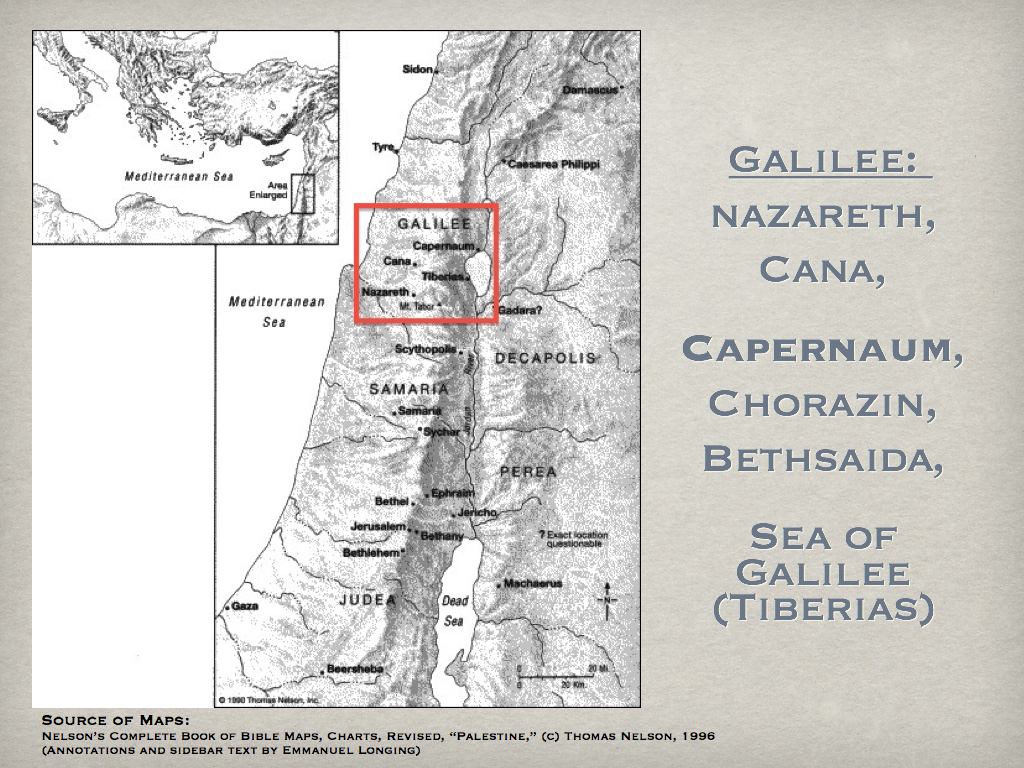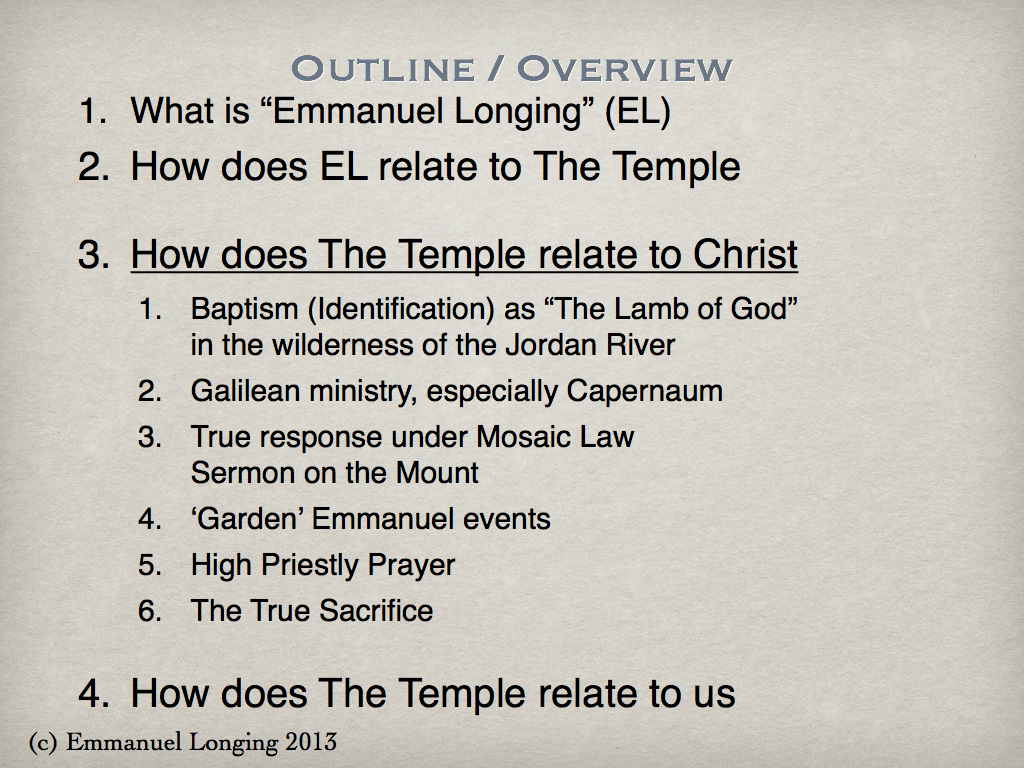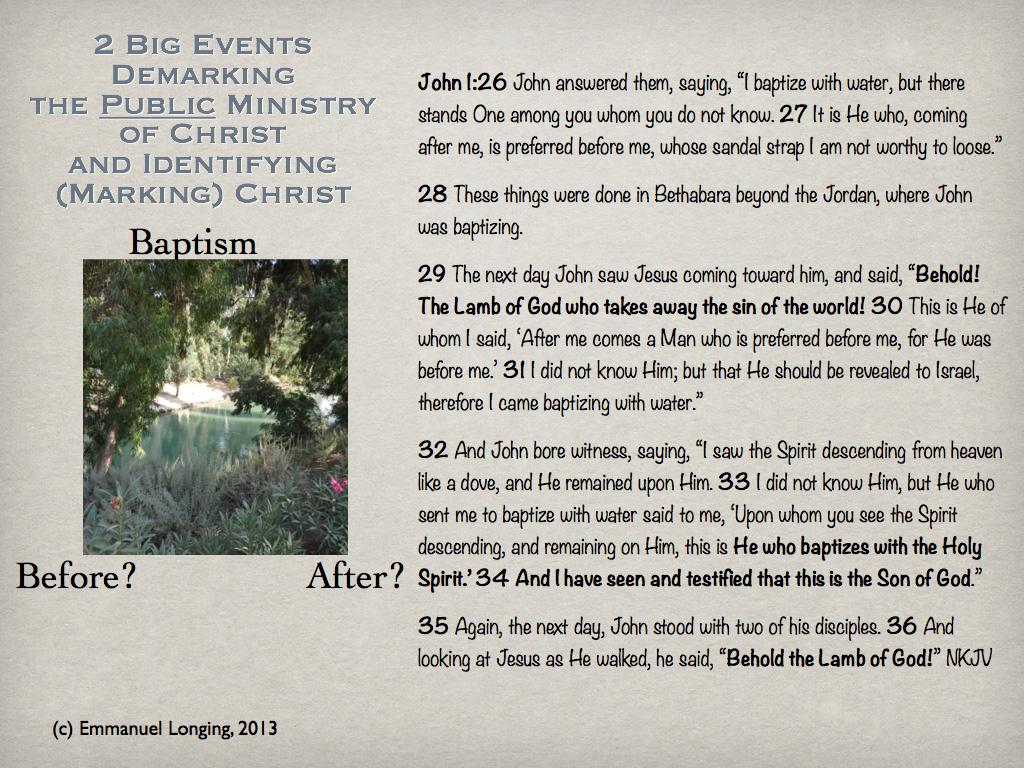Jesus presented Himself to the Jewish people as an adult in area of the Land known as Galilee, well to the north of Jerusalem and of the center of religious worship. Jesus Christ Himself is closely connected to the idea of Emmanuel Longing as we will see claimed in the New Testament.
Jesus Christ Himself is closely connected to the idea of Emmanuel Longing as we will see claimed in the New Testament. Let us begin with His first material public event, that is His baptism by John the Baptist (not to be confused with the Apostle John, the brother of James, and the author of the Gospel of John and three of the Epistles). Baptism is a Biblical (Greek) word that is a transliteration, not a translation. A common understanding of the root meaning of the Greek word is “to dip” or “immerse,” which suggests the idea of washing in the sense of cleaning as one would do of utensils before use in a meal. This may be correct and the full extent of the underlying idea.
Let us begin with His first material public event, that is His baptism by John the Baptist (not to be confused with the Apostle John, the brother of James, and the author of the Gospel of John and three of the Epistles). Baptism is a Biblical (Greek) word that is a transliteration, not a translation. A common understanding of the root meaning of the Greek word is “to dip” or “immerse,” which suggests the idea of washing in the sense of cleaning as one would do of utensils before use in a meal. This may be correct and the full extent of the underlying idea.
But the Greek word was used of dipping / immersing in the context of dyeing a garment, permanently marking / identifying the object with the impregnated color of the dye. Being clean would be an aspect of such understanding but the central point would be to an act of identification which is irreversible, permanent, and now the essential feature of what has been so marked. Let us think with this lens–the idea that to be Baptized is to be permanently identified in some specified way–in the context of the inaugural public event of Jesus. The imagery of the Lamb is a very important one both in Old Testament history and in worship at the Temple of God. During the Jewish people’s final night in slavery in Egypt, God foretold through Moses that He would take the life of the first born male of all the people and mammals in Egypt who had not put the blood of a sacrificed lamb on the doorposts and lintel (cross piece at the top of a door) at the entrance to their dwelling. God promised that when He saw the blood, He would “pass over” (hence the name Passover) that dwelling, sparing the first born.
The imagery of the Lamb is a very important one both in Old Testament history and in worship at the Temple of God. During the Jewish people’s final night in slavery in Egypt, God foretold through Moses that He would take the life of the first born male of all the people and mammals in Egypt who had not put the blood of a sacrificed lamb on the doorposts and lintel (cross piece at the top of a door) at the entrance to their dwelling. God promised that when He saw the blood, He would “pass over” (hence the name Passover) that dwelling, sparing the first born.
Israel, the Jewish people, were in a certain sense God’s first born. They were the people of God’s special blessing, entrusted with the Covenant, promises, and Temple of God YHWH. But that was not to be the end of God’s work in humanity. The Jewish people were not to be a ‘pipeline’ of God’s blessing to God’s Elect everywhere, not a ‘bucket’ exclusive to Jews only.
Further to this imagery is the role of a river. At the Exodus from Egypt, God through Moses performed the mighty miracle of separating the waters of the river enabling the Jewish people to walk, literally, out of Egypt into the wilderness toward the Land. Forty years later, under the leadership of Moses’s successor, Joshua, another miracle in the river occurred, this time it was the Jordan River separating the desert from the Land. Again the waters parted and the nation Israel walked across. Still later, God twice uses the miraculous parting the Jordan River first with the Prophet Elijah and then with Eiijah’s successor Elisha. Here in this Baptism scene we have John the Baptist as a type of New Testament Elijah separating the waters and permanently identifying Jesus as The Lamb of God.
During the inter-Testament period there arose many Synagogues, meeting places for Jews to share in reading the Old Testament and offer words of encouragement such as the hope even the expectation of a coming Messiah (deliverer) as promised in many places in the Old Testament. We are fortunate today that Capernaum was not overtaken by development or scraped clean from history. It is an archaeological treasure to this day. We can walk in its midst, even onto a synagogue from the 5th century A.D. and beneath it see the foundation stones for the synagogue as it existed at the time of Christ and which was the site of many of the miraculous acts of Jesus and his teaching.
We are fortunate today that Capernaum was not overtaken by development or scraped clean from history. It is an archaeological treasure to this day. We can walk in its midst, even onto a synagogue from the 5th century A.D. and beneath it see the foundation stones for the synagogue as it existed at the time of Christ and which was the site of many of the miraculous acts of Jesus and his teaching.